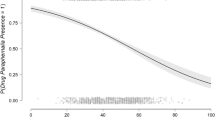Abstract
The rapid increase in fentanyl overdose deaths, particularly those also attributed to stimulants, has led to concerns about unintentional fentanyl exposure. Utilizing vital and medical record data, we identified overdose decedents from 2018 to 2021 in San Francisco who received care in the safety net system in the 3 years preceding death. Among 506 decedents, medical record evidence of pre-mortem opioid use was present for 48% of stimulant-only, 56% of stimulant-fentanyl, 65% of fentanyl-only, and 82% of non-fentanyl opioid decedents (p<0.001). Among stimulant-fentanyl decedents, an increase in 10 years of age (adjusted odds ratio (aOR) 0.74 [95% CI:0.59–0.94]) and race other than White or Black (aOR 0.36 [95% CI:0.15–0.87]) had lower odds of evidence of pre-mortem opioid use. While not conclusive, these findings raise the possibility that a significant proportion of fentanyl overdose decedents in San Francisco may have not intended to consume an opioid on the occasion of their death.
Similar content being viewed by others
References
Mattson CL, Tanz LJ, Quinn K, Kariisa M, Patel P, Davis NL. Trends and geographic patterns in drug and synthetic opioid overdose deaths - United States, 2013-2019. MMWR Morb Mortal Wkly Rep 2021;70(6):202–7.
Centers for Disease Control and Prevention. National Center for Health Statistics Mortality Data on CDC Wonder. Available at: https://wonder.cdc.gov/mcd.html. Published 2021. Accessed 2 Oct 2021.
Coffin PO, Galea S, Ahern J, Leon AC, Vlahov D, Tardiff K. Opiates, cocaine and alcohol combinations in accidental drug overdose deaths in New York City, 1990-98. Addiction 2003;98(6):739–47.
Ciccarone D. The rise of illicit fentanyls, stimulants and the fourth wave of the opioid overdose crisis. Curr Opin Psychiatry. 2021;34(4):344–50.
Centers for Disease Control and Prevention. Rising Numbers of Deaths Involving Fentanyl and Fentanyl Analogs, Including Carfentanil, and Increased Usage and Mixing with Non-opioids. Available at: https://emergency.cdc.gov/han/HAN00413.asp. Published 2018. Accessed 4 Dec 2021.
Nolan ML, Shamasunder S, Colon-Berezin C, Kunins HV, Paone D. Increased presence of fentanyl in cocaine-involved fatal overdoses: implications for prevention. J Urban Health 2019;96(1):49–54.
Tupper KW, McCrae K, Garber I, Lysyshyn M, Wood E. Initial results of a drug checking pilot program to detect fentanyl adulteration in a Canadian setting. Drug Alcohol Depend 2018;190:242–5.
Bauer LK, Brody JK, Leon C, Baggett TP. Characteristics of homeless adults who died of drug overdose: a retrospective record review. J Health Care Poor Underserved 2016;27(2):846–59.
Kral AH, Lambdin BH, Browne EN, et al. Transition from injecting opioids to smoking fentanyl in San Francisco, California. Drug Alcohol Depend 2021;227:109003.
Acknowledgements
This project was supported by NIDA grant K24DA042720 and CDC grant R01CE003364.
Author information
Authors and Affiliations
Corresponding author
Additional information
Publisher’s Note
Springer Nature remains neutral with regard to jurisdictional claims in published maps and institutional affiliations.
Appendix
Appendix
Rights and permissions
About this article
Cite this article
Coffin, P.O., McMahan, V.M. & Murphy, C. Evidence of Pre-mortem Opioid Use among Fentanyl Overdose Decedents in a Safety Net Healthcare System. J Urban Health 99, 865–872 (2022). https://doi.org/10.1007/s11524-022-00663-1
Published:
Issue Date:
DOI: https://doi.org/10.1007/s11524-022-00663-1




